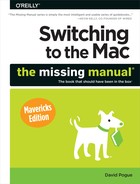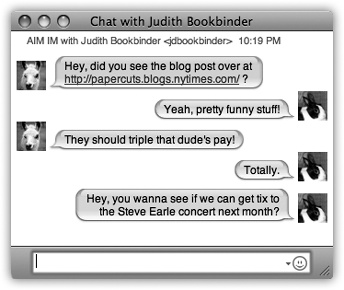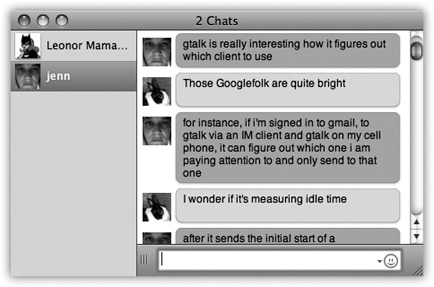A typed chat works like this: Each time you or your chat partner types something and then presses Return, the text appears on both of your screens (Figure 13-5).
Figure 13-5. As you chat, your comments always appear on the right. If you haven’t yet created a custom icon, you’ll look like a blue globe or an AOL running man. You can choose a picture for yourself either in your own Contacts card or right in Messages. And Web links your pals paste into messages are perfectly clickable—your Web browser leaps right up to take you to the site your friend has shared.
Messages displays each typed comment next to an icon, which can be any of these three things:
A picture the other person added. If the buddy added her own picture—to her own copy of Messages, a Jabber program, AOL Instant Messenger, or Yahoo Messenger—then it will be transmitted to you, appearing automatically in the chat window. Cool!
A picture you added. If you’ve added a picture of that person to the buddy list or to Contacts, you see it here instead. (After all, your vision of what somebody looks like may not match his own self-image.)
Generic. If nobody’s done any icon dragging of any sort, you get a generic silhouette icon.
To choose a graphic to use as your own icon, click the square picture to the right of your own name at the top of the buddy list. From the pop-up palette of recently selected pictures, choose Edit Picture to open a pop-up image-selection palette, where you can take a snapshot with your Mac’s camera or choose a photo file from your hard drive. Feel free to build an array of graphics to represent yourself—and to change them in midchat, using this pop-up palette, to the delight or confusion of your conversation partner.
Tip
When you minimize the Messages message window, its Dock icon displays the icon of the person you’re chatting with—a handy reminder that she’s still there.
Typing isn’t the only thing you can do during a chat. You can also perform any of these stunts:
Format your text. You can press ⌘-B or ⌘-I to make your next typed utterance bold or italic. Or change your color or font by choosing Format→Show Colors or Format→Show Fonts, which summons the standard OS X color or font palettes. (If you use some weird font that your chat partners don’t have installed, then they won’t see the same typeface.)
Insert a smiley. When you choose a face (like Undecided, Angry, or Frown) from this quick-access menu of smiley options (at the right end of the text-reply box), Messages inserts it as a graphic into your response.
On the other hand, if you know the correct symbols to produce smileys—that “:)” means a smiling face, for example—you can save time by typing them instead of using the pop-up menu. Messages converts them into smiley icons on the fly, as soon as you send your reply.
Send a file. Choosing Buddies→Send File lets you send a file to all the participants in your chat.
Better yet, just drag the file’s icon from the Finder into the box where you normally type. (This trick works well with pictures, because your conversation partner sees the graphic right in his Messages window. And it can handle files as big as 100 megabytes.)
This is a fantastic way to transfer a file that would be too big to send by email. A chat window never gets “full,” and no attachment is too large to send.
This method halves the time of transfer, too, since your recipients get the file as you upload it. They don’t have to wait 20 minutes for you to send the file and then another 20 minutes to download it, as they would with email or FTP.
If you have multiple conversations taking place—and are flinging files around to a bunch of people—you can keep an eye on each file’s progress with the File Transfer Manager. Choose Window→File Transfers (or press Option-⌘-L) to pop open an all-in-one document delivery monitor.
Get Info on someone. If you click a name in your buddy list and then choose Buddies→Show Info (or right-click someone’s name and choose Show Info from the shortcut menu), you get a little Info window about your buddy where you can edit her name, email address, and picture. (If you change the picture here, you’ll see it instead of the graphic your buddy chose for herself.)
If you click the Alerts tab at this point, you can make Messages react when this particular buddy logs in, logs out, or changes status—for example, by playing a sound or saying, “She’s here! She’s here!”
Send an Instant Message. Not everything in a chat session has to be “heard” by all participants. If you choose Buddies→Send Instant Message, you get a private chat window, where you can “whisper” something directly to a special someone behind the other chatters’ backs.
Send Email. If someone messages you, “Hey, will you email me directions?” you can do so on the spot by choosing Buddies→Send Email. Your email program opens up automatically so you can send the note along; if your buddy’s email address is part of his Contacts info, then the message is even preaddressed.
The words you might have for Messages’ word-balloon design might be “cute” and “distinctive.” But it’s equally likely that your choice of adjectives includes “juvenile” and “annoying.”
Fortunately, behind Messages’ candy coating are enough options tucked away in the View→Messages menu that you’ll certainly find one that works for you (see Figure 13-6).
Figure 13-6. Messages can look like almost anything. Here, for example, is what a chat looks like with the balloon effect turned off (giving you colored rectangles instead). You can even turn off pictures if they bother you, or hide the names. You can also change the color and typeface settings in the Messages→Preferences→Messages panel.


